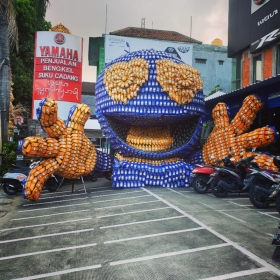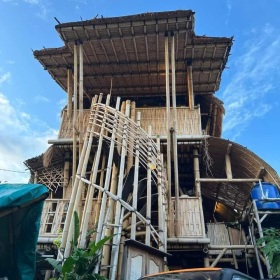
Since my hippy days living out at Mary Farms after a Rainbow Gathering in Far North Queensland, I have had quite an appreciation for having a roof over one’s head. Also since renovating a house that had roof-leak problems… there’s nothing like being able to stay dry and warm in some cases. The sound of the monsoon clanging on a metal roof and filling one’s ears and world with its smooth feathery sound is one best appreciated when you know you don’t have to run around checking for leaks (or lie under one).
Yeah, I like roofs.
In my hippy days I lived under a tarpaulin which blew away and disintegrated at soon as the monsoon started (pretty much the end of that hippy soliloquy).
Fast Forward and I’m now working on an affordable way to make a fast roof without tiles or tin… using bamboo and woVen bamboo bedeck as our skeletal frame and ‘tendons’…. We are experimented with a bioplastic-like cassava flour glue that was cooked on the stove (flour mixed with water) and mixed with sand – formed a “plaster” which seemed fine over a cob wall that doesn’t get “wet” from the rain. However, the mixture didn’t hold up and it was super hard to work with (like something globby out of ghostbusters) – we also added in some calcium carbonate but it was pretty much a FAIL. So, we’ve gone for a ferros cement style instead. (Did I mentioN I like to stay dry during the rainy season?)
I think it’s a winner. I watched a DVD on Ferros Cement building a while ago and there’s a lot of ri-bar and wire mesh involved. However, because our (this is covering our Eatern-side-roof extension on the house) structure is “self-holding” and really we just want to smear a waterproof shell over it, And because bamboo is so “light” (compared to steel), we just attached a fine gauge galvanised mesh (0.5cm) to the bamboo structure and plastered that baby (not so easy on the near vertical slope that pretty much butts right up to our neighbours’ wall).
Material-wise – we used a mix of mill and cement. (I still haven’t figured out what is this “mill” …. but they use it to make walls apparently. I think it’s a derivative of limestone). That was on the top “arch” – then where our steep drop-off goes into gecko-only territory, I bought fabric, dipped it into another mix (with Calcium this time and cement and wood glue…. which I’ve seem made into a flooring “plaster”) and stuck that baby right onto the outside of the bedek (woven bamboo skin panelling) and then painted the lot with outdoor waterproofing paint.
Our previous attempt progressed to mixing calcium and wood glue which wasn’t stable without cement mixed in… We coated it with a waterproofing membrane but – let’s just not go there…. Just get the professionals like this Bapak. Oh yeah, so we mixed in a touch of sand and also “kambing/gamping” – another form of lime which makes water boil when you pour it in there and it strengthens the mix. Our mix: 3 parts mill, 1.5-2 parts cement, 1 part sand, 1/2-1/4 part kambing.
This all came from Supri’s idea a while back to just get old clothes, t-shirts etc, dip them in cement and cover the roof with them. Seeing as I don’t have that many old clothes….. I did buy the fabric. It’s called Paros here. Around 80c/metre AUD. When you look at it up close, it’s like a fine mesh and its quite thin. Hopefully it will hold up – initially I just wanted to stop the cement mix falling through the holes in the bedek – and I could have used something stronger in retrospect… But, the roof is nearly vertical and the plaster mix is calcium, cement and white glue … it was also just a means to get the plaster onto the bedek so we could seal the holes and paint it.



















